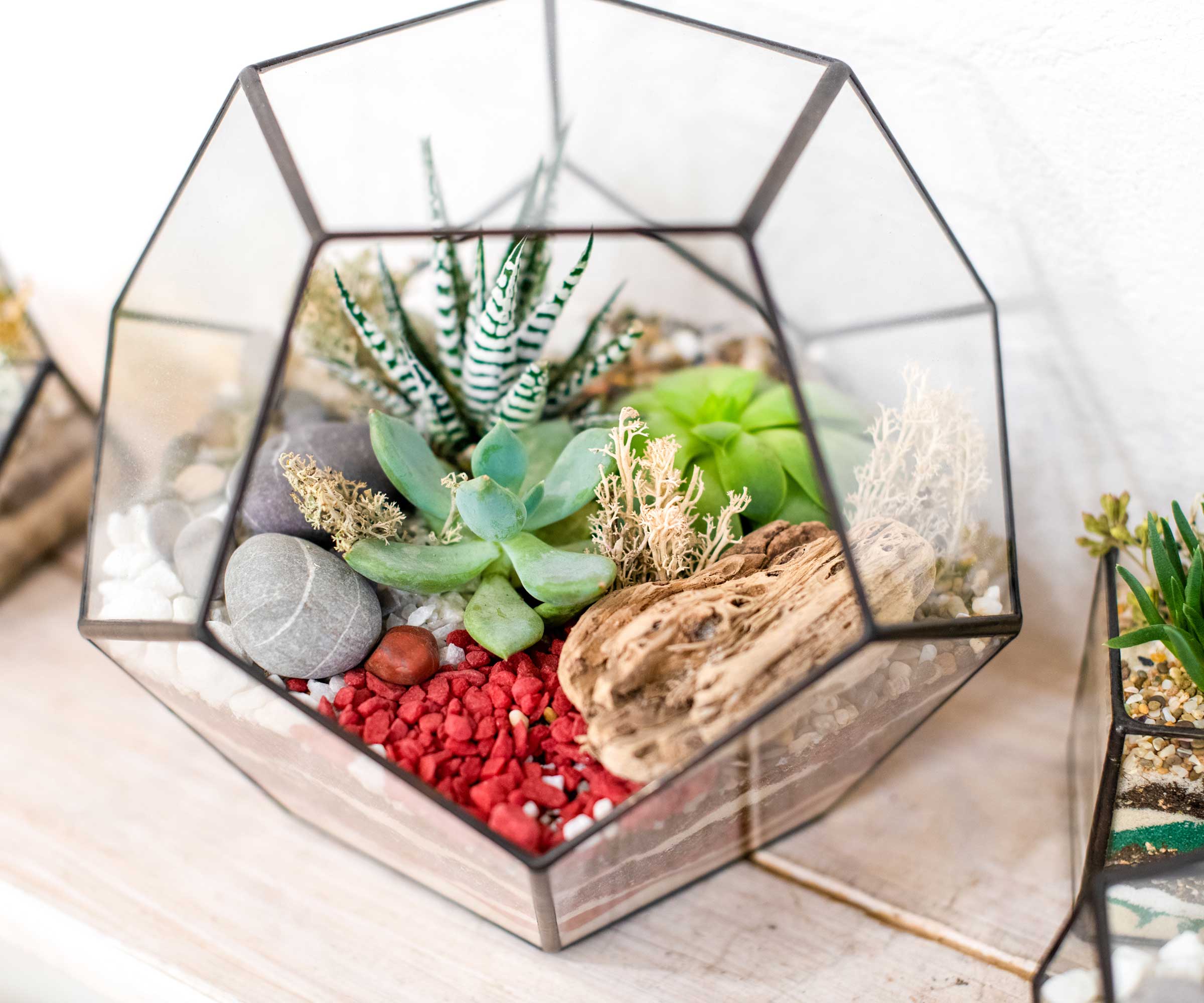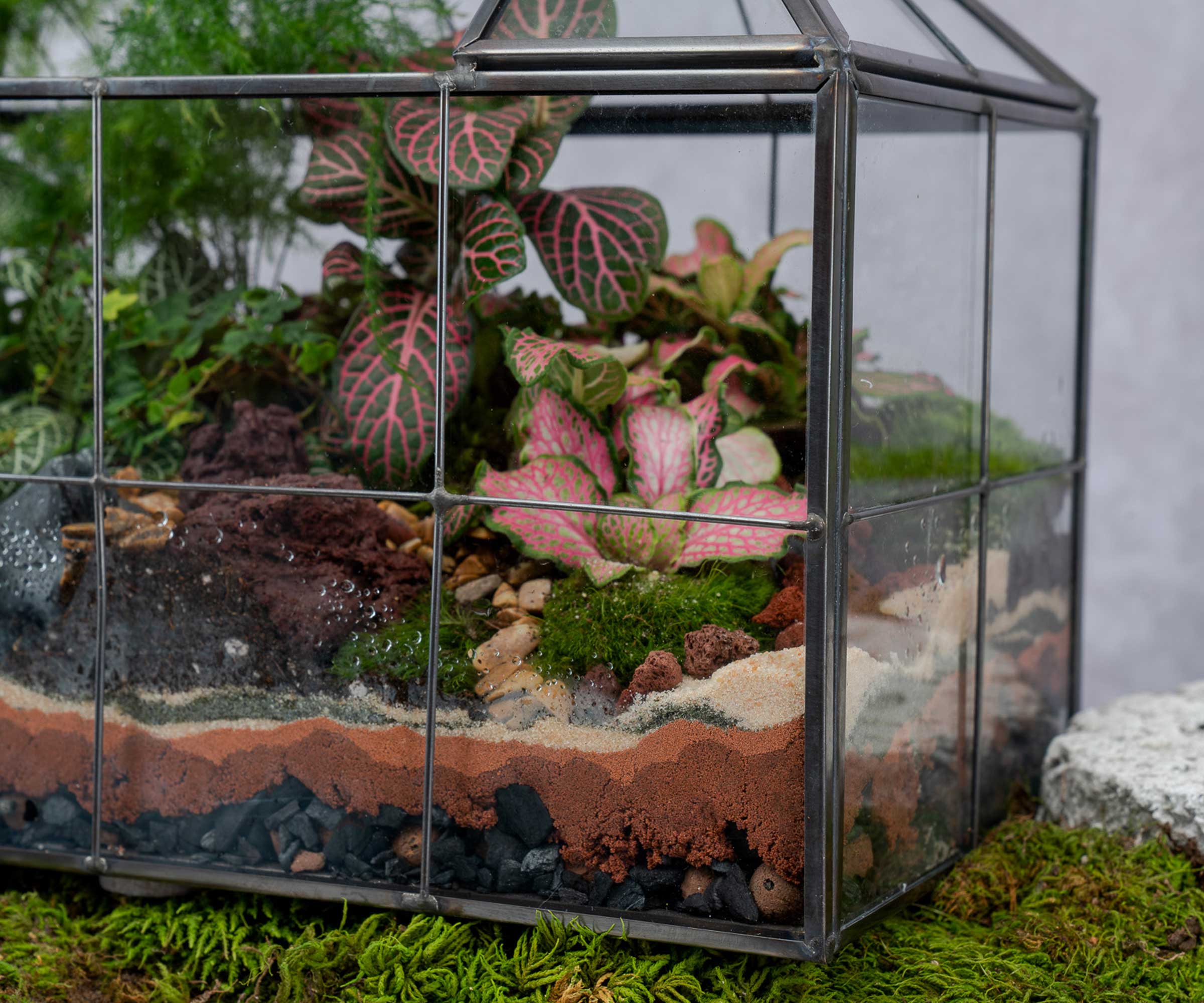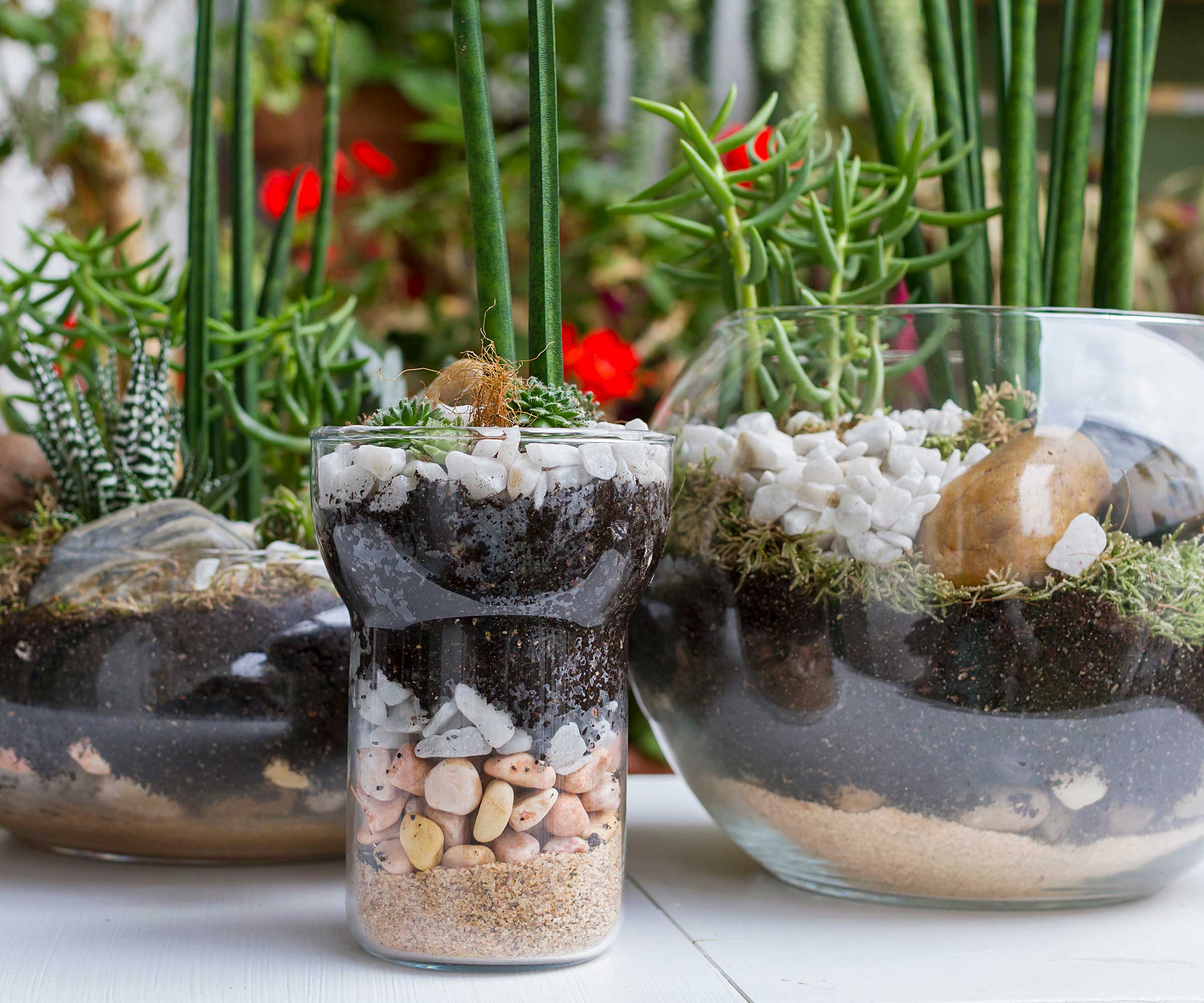Terrarium care – expert advice on how to look after these miniature botanical beauties
These expert tips will help you maintain your terrarium properly and keep it looking its best


Terrariums are one of the most interesting ways to display indoor plants, and have gained a recent surge in popularity. Encased in glass, these miniature worlds can be made up of an array of tropical or arid plants, and add a sense of botanical wonder to any interior scheme.
If you want to add more houseplants to your bedroom, kitchen, or living room, a terrarium can be the perfect solution. 'Whether you have limited shelf space or are looking for a grand centerpiece for your dining room table, terrariums come in a range of sizes from small bottles and jars to larger bowls,' says Sam Rodwell, the founder of Stem & Co.
'A well-constructed terrarium made from quality substrates and materials will enable you to retain a long-lasting design with barely any maintenance required,' continues Sam. However, like all indoor plants, there are a few essential care tips to bear in mind to help them thrive.

Sam Rodwell founded Stem & Co in 2007, which is located on the Lincolnshire coast in the UK. Sam and her team of experienced plant care specialists offer a meticulously curated collection of rare, air-purifying, and low-maintenance houseplants, as well as help and advice for plant parents. Sam is also a qualified florist and a horticultural student.

Terrariums come in all shapes and sizes
How to look after a terrarium – essential care tips
These maintenance tasks aren't too tricky, but they're important to stay on top of. Otherwise, your beautiful display can quickly turn into a sorry sight.

Succulents are well-suited to open terrariums
Where to position your terrarium
'Providing the right amount of light is crucial for your terrarium's health,' says Charly Uzcategui, the founder of Terrart NYC.
In most cases, they need to be somewhere with bright, but indirect light. 'East or north-facing windows would be a great choice,' says houseplant expert Vladan Nikolic. Avoid locations with direct sunlight, since the heat can rise quickly and this could damage the plants, he adds.
However, remember to research the specific care requirements of the plants in your terrarium, as different plants may have varying needs, notes Autumn Hilliard-Knapp of Perfect Plants Nursery.
Design expertise in your inbox – from inspiring decorating ideas and beautiful celebrity homes to practical gardening advice and shopping round-ups.
'An arid, open-style terrarium containing plants such as cacti, sedums, and succulents may withstand more light than a closed design containing an array of tropical and higher-humidity-loving plants,' adds Sam.

Charly Uzcategui grew up surrounded by plants in Venezuela. His passion for terrariums comes from his parents, who have been creating these beautiful and sustainable arrangements for more than 30 years. After studying engineering, specializing in geosciences, Charly moved to New York. Here, he founded Terrart NYC, which provides unique plant decor ideas and solutions for residential, commercial, and office spaces, as well as workshops and events.

Vladan Nikolic, otherwise known as Mr. Houseplant, is a houseplant expert with over 10 years of experience. He is the Founder of the houseplant care blog MrHouseplant.com and also an influencer who helps newcomers in the houseplant world become great plant parents. You can find him on Instagram, TikTok, Youtube, Facebook, Twitter and Pinterest.

Autumn is a horticulture specialist and marketing professional at Perfect Plants Nursery. With four years of experience in the horticulture industry, she has developed a passion for helping people create beautiful indoor and outdoor spaces to enjoy. Her expertise in horticulture encompasses a broad range of activities, including plant care and selection, landscape design, and maintenance.

Most terrariums need bright but indirect light
Note that natural lighting may change throughout the year as the seasons shift, so be prepared to move your terrariums if needed. 'If natural light is insufficient, especially during the winter months, consider using growing lights,' suggests Katie Palmowska, founder of Tropical Glass. 'These are specially designed to provide plants with the spectrum of light they need to photosynthesize effectively.'
It's essential to maintain a stable temperature around your terrarium, too, Katie highlights. 'Sudden and significant temperature drops can lead to the contraction of the glass, which may cause it to crack or break,' she explains. 'Always place your terrarium in a location where it won't be exposed to drastic temperature fluctuations.'
Top tip: 'Plants that receive light from a window will gradually lean in that direction,' Vladan says. 'To keep the terrarium attractive and balanced, rotate it from time to time.'

Katie is the founder of Tropical Glass, together with her partner. Her passion for terrarium making evolved from a cherished hobby into a thriving livelihood. Growing up in a plant-filled household, Katie absorbed the art of plant care through osmosis, learning from her mother's nurturing touch.

Avoid direct sunlight as it may damage your plants
How to water a terrarium
Watering houseplants properly is important for keeping them healthy – and terrariums are no exception. In fact, getting the balance wrong is a common terrarium mistake that can prove fatal to your precious plants.
You can check the moisture levels in your terrarium by placing a finger or wooden stick into the soil, says Charly Uzcategui. 'If it feels dry to the touch, it's time to water. If it's still moist, wait a few more days before checking again.'
Closed terrariums need less watering than open designs. In closed styles, an absence of condensation is a telltale sign that it's time to water, Vladan says. 'Since terrariums don't have drainage holes, watering should always be light,' he adds. 'Heavy watering will lead to water stagnation, which creates conditions for root diseases.'
Geometric forms with metal joins often have gaps that allow for more air circulation, Charly says, which results in a faster moisture loss rate. 'On the other hand, terrariums with cork-sealed tops, such as jars or bottles, create a more effective condensation process, reducing the need for frequent watering to every three to six months,' he adds.

Closed terrariums need less watering than open designs
To control the flow of the water and avoid overdoing it, Charly Uzcategui recommends using a spray or squeeze bottle or a narrow-spout watering can. 'Aim for the soil around the plants rather than directly onto them,' he says. 'This allows the water to seep slowly into the soil, mimicking natural rainfall.'
He also highlights the importance of including a layer of gravel or small rocks at the bottom of your terrarium, which creates space for excess water to collect.
Finally, it's important to recognize that seasonal changes can impact your terrarium's water requirements. Charly explains: 'During the hotter months, your terrarium may need more frequent watering due to increased evaporation. Conversely, in cooler months, reduce watering to prevent over-hydration.'
Top tip: 'If your terrarium contains cushion moss, it's essential to monitor it regularly,' says Katie Palmowska. 'Should the moss start losing its vibrant color or feel dry to the touch, consider misting it with one or two sprays of water to rejuvenate it.'

A layer of gravel at the bottom of your terrarium will assist with drainage
How to prune terrarium plants
Your terrarium plants will gradually start to outgrow their limited space, says Vladan Nikolic. Trimming them as needed will keep them neat.
'Certainly snip away leaves that touch the glass,' advises Sam Rodwell. Otherwise, bacteria can form due to the excess humidity, and cause them to rot.
The best tool to use is a pair of clean and sharp aquatic scissors, which are long and curved – ideal for making precise cuts in hard-to-reach areas. These aquatic scissors from the Mandala Crafts Store at Amazon are well-rated.
'If some of the plants become too unruly or large, you can pull them out and replace them with another plant,' adds Vladan. 'This is a great opportunity to experiment, change things up, and try new plants.'

Pruning may be required to keep your plants the right size
FAQs
Do you need to clean terrariums?
'Cleaning the glass maintains a good-looking design and also allows the plants to photosynthesize correctly,' says Sam Rodwell of Stem & Co. You can use warm water and a few paper towels to wipe the surfaces. Remember to clean both the inside and the outside of your terrarium.
As well as this, any dead plants should be removed regularly using a pair of aquarium tweezers, such as these well-rated ones from Amazon. Decorative rocks may also need a clean from time to time.
How do I get rid of fungus gnats in my terrarium?
Fungus gnats often appear when the terrarium environment is kept too wet, says Katie Palmowska of Tropical Glass. 'If you notice them, it's essential to open the terrarium to air it out and allow the soil to dry. Adding a layer of gravel on top of the soil can also help prevent their appearance, as it reduces the surface moisture that these pests are attracted to.
'If you find a significant number of fungus gnats, consider using yellow sticky traps,' Katie continues. 'Place them inside the closed terrarium, where they'll attract and capture the gnats.'
There is mold growing in my terrarium – what should I do?
If you catch it quickly, mold can simply be wiped off from plants' leaves. Then, you can discourage its regrowth by reducing wetness and humidity in your terrarium. Ways to do this include removing the lid of a closed terrarium for a few hours or so; checking the terrarium isn't getting too hot in its current position; and assessing your watering habits – you may be slightly overdoing it.
Should you fertilize a terrarium?
Usually, a fertilizer isn't necessary for healthy terrarium plants as you'll want to keep their size small enough to fit in their vessel. 'However, if you notice weakened growth or pale leaves, use a diluted, slow-release fertilizer specifically formulated for terrarium plants,' says Autumn Hilliard-Knapp of Perfect Plants Nursery.
Whether you've filled your terrarium with succulents or tropical plants, there is a design to suit every budget and home. And, by looking after it properly, you'll be able to enjoy its gorgeous aesthetic for years to come.

Holly started writing about gardening five years ago, and she is a regular contributor to Homes & Gardens. She has also written many gardening features for Woman & Home and Real Homes, too. She has previous experience as a professional gardener, where she helped to plant and maintain private gardens. Holly has also looked after allotment plots over the years and loves to grow her own flowers and veggies from seed. In her spare time, she enjoys visiting local gardens, botanical drawing, and tending to her ever-growing collection of houseplants.